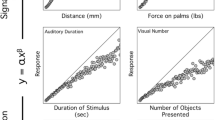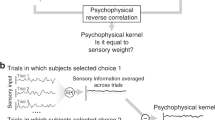Abstract
Stevens’ power law for the judgments of sensation has a long history in psychology and is used in many psychophysical investigations of the effects of predictors such as group or condition. Stevens’ formulation \(\varPsi = {aP}^{n}\), where \(\varPsi \) is the psychological judgment, P is the physical intensity, and \(n\) is the power law exponent, is usually tested by plotting log \((\varPsi )\) against log (P). In some, but by no means all, studies, effects on the scale parameter, \(a\), are also investigated. This two-parameter model is simple but known to be flawed, for at least some modalities. Specifically, three-parameter functions that include a threshold parameter produce a better fit for many data sets. In addition, direct non-linear computation of power laws often fit better than regressions of log-transformed variables. However, such potentially flawed methods continue to be used because of assumptions that the approximations are “close enough” as to not to make any difference to the conclusions drawn (or possibly through ignorance the errors in these assumptions). We investigate two modalities in detail: duration and roughness. We show that a three-parameter power law is the best fitting of several plausible models. Comparison between this model and the prevalent two parameter version of Stevens’ power law shows significant differences for the parameter estimates with at least medium effect sizes for duration.


Similar content being viewed by others
References
Allan, L. G. (1983). Magnitude estimation of temporal intervals. Perception and Psychophysics, 33(1), 29–42. doi:10.3758/BF03205863.
Anderson, N. H. (1970). Functional measurement and psychophysical judgment. Psychological Review, 77(3), 153.
Beck, A., Ward, C., Mendelson, M., Mock, J., & Erbaugh, J. (1961). An inventory for measuring depression. Archives of General Psychiatry, 4(6), 561–571. doi:10.1016/S0010-440X(61)80020-5.
Borg, G. (1962). Physical performance and perceived exertion (Vol. XI). Lund, Sweden: Gleerup.
Borg, G. (1998). Borg’s perceived exertion and pain scales. Champaign, IL: Human Kinetics.
Borg, G., Hassmen, P., Lagerstrum, M. (1987). Perceived exertion related to heart rate and blood lactate during arm and leg exercise. European Journal of Applied Physiology and Occupational Physiology, 56(6), 679–685. doi:10.1007/BF00424810.
Borg, G., Lindblad, I., & Holmgren, A. (1981). Quantitative evaluation of chest pain. Acta Medica Scandinavica, 209(S644), 43–45. doi:10.1111/j.0954-6820.1981.tb03117.x.
Borg, G., Van Den Burg, M., Hassmen, P., Kaijser, L., & Tanaka, S. (1987). Relationships between perceived exertion hr and hla in cycling running and walking. Scandinavian Journal of Sports Sciences, 9(3), 69–78.
Borg, G. V., & Marks, L. (1983). Twelve meanings of the measure constant in psychophysical power functions. Bulletin of the Psychonomic Society, 21(1), 73–75. doi:10.3758/BF03329958.
Edwards, A. L. (1983). Techniques of attitude scale construction. New York, NY: Irvington.
Edwards, W. (1954). The theory of decision making. Psychological Bulletin, 51(4), 380–417.
Eisler, H. (1976). Experiments on subjective duration 1868–1975: A collection of power function exponents. Psychological Bulletin, 83(6), 1154–1171. doi:10.1037/0033-2909.83.6.1154.
Eisler, H., & Eisler, A. D. (1992). Time perception: Effects of sex and sound intensity on scales of subjective duration. Scandinavian Journal of Psychology, 33(4), 339–358. doi:10.1111/j.1467-9450.1992.tb00923.x.
Ekman, G. (1959). Weber’s law and related functions. The Journal of Psychology, 47(2), 343–352.
Florentine, M., & Epstein, M. (2006). To honor stevens and repeal his law (for the auditory system. Paper presented at the Fechner Day 2006. Proceedings of the 22nd Annual Meeting of the International Society for Psychophysics, St. Albans, UK. http://www.ispsychophysics.org/fd/index.php/proceedings/article/view/332/324.
Fucci, D., Petrosino, L., Hallowell, B., Andra, L., & Wilcox, C. (1997). Magnitude estimation scaling of annoyance in response to rock music: Effects of sex and listeners’ preference. Perceptual and Motor Skills, 84(2), 663–670.
Galanter, E. (1962). The direct measurement of utility and subjective probability. The American Journal of Psychology, 75(2), 208–220. http://links.jstor.org/sici?sici=0002-9556.
Galanter, E. (1990). Utility Functions for Nonmonetary Events. The American Journal of Psychology, 103(4), 449–470. http://www.jstor.org/stable/1423318.
Kahneman, D., & Tversky, A. (1979). Prospect theory. Economerica, 47, 263. doi:10.2307/1914185.
Kornbrot, D. E., Donnelly, M., & Galanter, E. (1981). Estimates of utility function parameters from signal-detection experiments. Journal of Experimental Psychology-Human Perception and Performance, 7(2), 441–458. doi:10.1037/0096-1523.7.2.441.
Kornbrot, D. E., Msetfi, R. M., & Grimwood, M. J. (2013). Time perception and depressive realism: judgment type, psychophysical functions and bias. PLoS ONE, 8(8), e71585. doi:10.1371/journal.pone.0071585.
Kornbrot, D. E., Penn, P., Petrie, H., Furner, S., & Hardwick, A. (2007). Roughness perception in haptic virtual reality for sighted and blind people. [Article]. Perception & Psychophysics, 69, pp. 502–512. doi:10.3758/BF03193907, http://hdl.handle.net/2299/2959.
Likert, R., Roslow, S., & Murphy, G. (1993). A simple and reliable method of scoring the Thurstone attitude scales. Personnel Psychology, 46(3), 689–690. doi:10.1111/j.1744-6570.1993.tb00893.x.
Lindsay, D. R. J., & Norman, D. A. (1977). Human information processing (3rd ed.). London: Academic.
Marks, L. E., & Cain, W. S. (1972). Perception of intervals and magnitudes for three prothetic continua. Journal of Experimental Psychology, 94(1), 6–17. doi:10.1037/h0032746.
Marks, L. E., & Stevens, J. C. (1966). Individual brightness functions. Perception and Psychophysics, 1(1), 17–24. doi:10.3758/BF03207815.
Marks, L. E., & Stevens, J. C. (1968). The form of the psychophysical function near threshold. Perception and Psychophysics, 4(5), 315–318. doi:10.3758/BF03210523.
McGraw, A. P., Larsen, J. T., Kahneman, D., & Schkade, D. (2010). Comparing gains and losses. Psychological Science, 21(10), 1438–1445. doi:10.1177/0956797610381504.
Mountcastle, V. B., Poggio, G. F., & Werner, G. (1963). The relation of thalamic cell response to peripheral stimuli varied over an intensive continuum. Journal of Neurophysiology, 26, 807–834.
Norman, G. (2010). Likert scales, levels of measurement and the “laws” of statistics. Advances in health sciences education, 15(5), 625–632. doi:10.1007/s10459-010-9222-y.
Sellin, T., & Wolfgang, M. E. (1964). The measurement of delinquency. New York, NY: Wiley.
Sellin, T., & Wolfgang, M. E. (1978). The measurement of delinquency (2nd ed.). New York, NY: Wiley.
Steingrimsson, R. (2011). Evaluating a model of global psychophysical judgments for brightness: II. Behavioral properties linking summations and productions. Attention. Perception and Psychophysics, 73(3), 872–885. doi:10.3758/s13414-010-0067-5.
Steingrimsson, R., & Luce, R. D. (2005a). Evaluating a model of global psychophysical judgments. I: Behavioral properties of summations and productions. Journal of Mathematical Psychology, 49(4), 290–307. doi:10.3758/APP.71.8.1916.
Steingrimsson, R., & Luce, R. D. (2005). Evaluating a model of global psychophysical judgments. II: Behavioral properties linking summations and productions. Journal of Mathematical Psychology, 49(4), 308–319. doi:10.1016/j.jmp.2005.03.001.
Steingrimsson, R., & Luce, R. D. (2006). Empirical evaluation of a model of global psychophysical judgments: III. A form for the psychophysical function and intensity filtering. Journal of Mathematical Psychology, 50(1), 15–29. doi:10.1016/j.jmp.2005.11.005.
Steingrimsson, R., & Luce, R. D. (2007). Empirical evaluation of a model of global psychophysical judgments: IV. Forms for the weighting function. Journal of Mathematical Psychology, 51(1), 29–44. doi:10.1016/j.jmp.2006.08.001.
Steingrimsson, R., & Luce, R. D. (2012). Predictions from a model of global psychophysics about differences between perceptual and physical matches. Attention Perception and Psychophysics, 74(8), 1668–1680. doi:10.3758/s13414-012-0334-8.
Stevens, J. C. (1974). Families of converging power functions in psychophysics. In H. R. Moskowitz, B. Scharf, & J. C. Stevens (Eds.), Sensation and measurement: Papers in honor of S. S. Stevens. Oxford, England: D. Reidel.
Stevens, J. C. (1990). Perceived roughness as a function of body locus. Attention Perception and Psychophysics, 47(3), 298–304. doi:10.3758/BF03205004.
Stevens, J. C., & Marks, L. E. (1980). Cross-modality matching functions generated by magnitude estimation. Perception and Psychophysics, 27(5), 379–389. doi:10.3758/BF03204456.
Stevens, J. C., & Marks, L. E. (1999). Stevens power law in vision: Exponents, intercepts, and thresholds. Fechner Day, 99, 82–87.
Stevens, S. S. (1946). On the theory of scales of measurement. Science, 103, 677–680. http://www.jstor.org/stable/1671815.
Stevens, S. S. (1961). To honour Fechner and repeal his law. Science, 133, 80–86. doi:10.1126/science.133.3446.80.
Stevens, S. S. (1975). Psychophysics. New York, NY: Wiley.
Stevens, S. S., & Galanter, E. H. (1957). Ratio scales and category scales for a dozen perceptual continua. Journal of Experimental Psychology, 54, 377–411. doi:10.1037/h0043680.
Stevens’ Power Law. Retrieved August 18, 2013 from http://en.wikipedia.org/wiki/Stevens%27_power_law.
Teghtsoonian, R. (1971). On the exponents in Stevens’ law and the constant in Ekman’s law. Psychological Review, 78, 71–80.
Teghtsoonian, R. (2012). The standard model for perceived magnitude: A framework for (almost) everything known about it. American Journal of Psychology, 125(2), 165–174. doi:10.5406/amerjpsyc.125.2.0165.
Tversky, A. (1967). Additivity, utility and subjective probability. Journal of Mathematical Psychology, 4, 175–202.
West, R., Ward, L., & Khosla, R. (2000). Constrained scaling: The effect of learned psychophysical scales on idiosyncratic response bias. Attention Perception and Psychophysics, 62(1), 137–151. doi:10.3758/BF03212067.
Acknowledgments
I would like to thank Joseph Glicksohn, Robert Teghtsoonian, and a third anonymous reviewer together with Editor Alberto Maydeu-Olivare for extremely perceptive and constructive comments on earlier versions of this Ms. I would also like to thank members of the International Society for Psychophysics for helpful discussions and email comments.
Author information
Authors and Affiliations
Corresponding author
Electronic supplementary material
Below is the link to the electronic supplementary material.
Rights and permissions
About this article
Cite this article
Kornbrot, D.E. Human Psychophysical Functions, an Update: Methods for Identifying their form; Estimating their Parameters; and Evaluating the Effects of Important Predictors. Psychometrika 81, 201–216 (2016). https://doi.org/10.1007/s11336-014-9418-9
Received:
Published:
Issue Date:
DOI: https://doi.org/10.1007/s11336-014-9418-9




